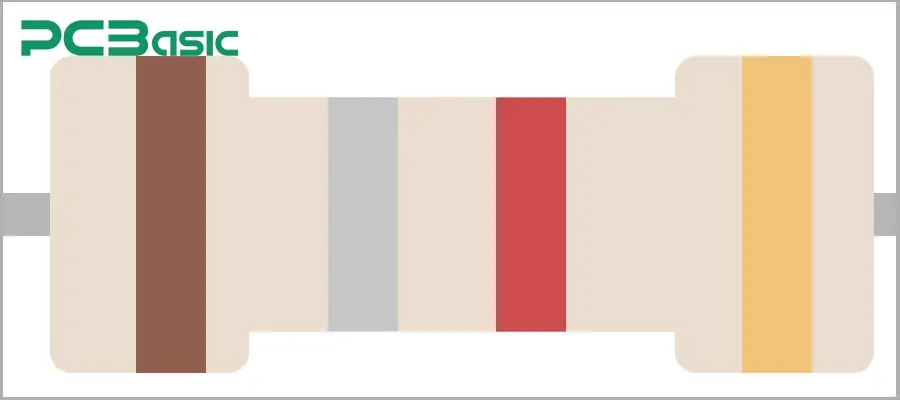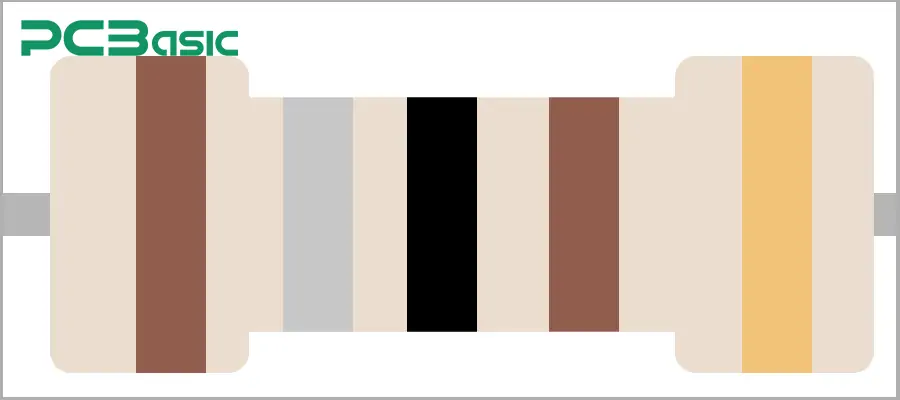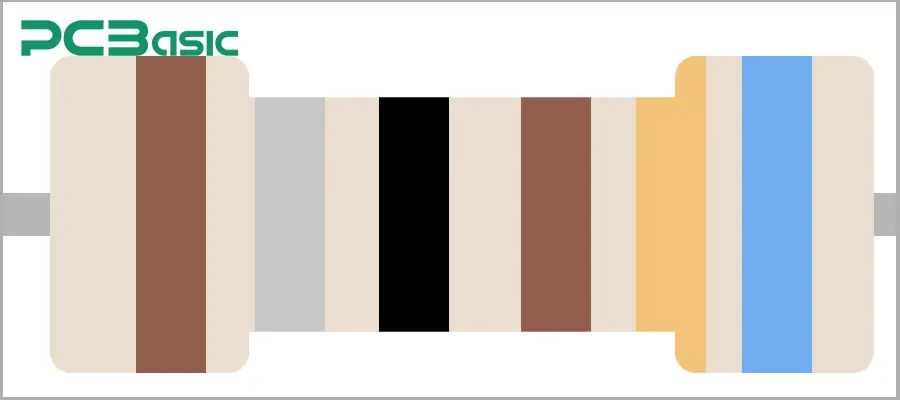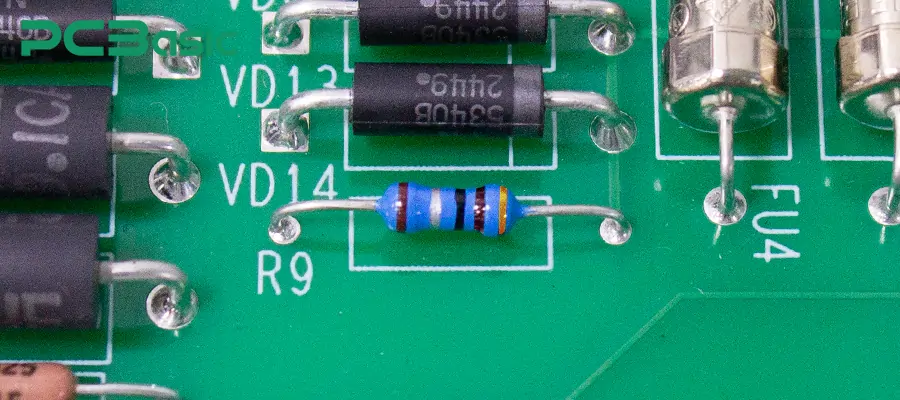

Global high-mix volume high-speed PCBA manufacturer
9:00 -18:00, Mon. - Fri. (GMT+8)
9:00 -12:00, Sat. (GMT+8)
(Except Chinese public holidays)


Global high-mix volume high-speed PCBA manufacturer
9:00 -18:00, Mon. - Fri. (GMT+8)
9:00 -12:00, Sat. (GMT+8)
(Except Chinese public holidays)
HomePage > Blog > Knowledge Base > 1.8K Resistor Color Code — A Complete Guide
If you have ever looked at the internal structure of some of the devices you use daily, you must have seen resistors. Resistors are one of the most common components in electronic devices, and they are present in almost every device. However, the reading of the resistor's value is not by looking at the number on it. In fact, there is no number on the resistor. Because its size is too small, we cannot print numbers on it. Therefore, in order to make it convenient and accurate to know the resistance value of the resistor, manufacturers use color bands to indicate the resistance value, multiplier, and tolerance of the resistor. This is the color coding of resistors. This standard was initially established by the Electronic Industries Association and has since been widely used. This method is simple, fast, and can accurately express the relevant values of the resistor.
Next, in this article, we will provide a detailed discussion on the color code for 1.8K resistors. After reading this article, you will understand how 1.8K ohm resistors are represented in 4-band, 5-band, and 6-band formats, and you will also learn how to select the appropriate type for different applications.

A resistor is the most basic passive electronic component. Its function is to impede the flow of current, thereby generating voltage drop in the circuit and controlling the current size. Usually, the value of the resistor is measured in ohms (Ω). For example, the resistance value of a 1.8K resistor is 1800 ohms. The value of 1800 ohms is large enough to effectively limit the current, but at the same time, it is not too high, ensuring the normal operation of the circuit.
Among various standard resistance values, the 1.8K ohm resistor falls within a very practical "mid-range resistance value range". It is neither as low as a few hundred ohms, which would cause excessive current; nor as high as several thousand kilohms, which would result in insufficient current. The balanced characteristic of the 1.8K resistor enables it to often be used to achieve the best compromise between current control and voltage distribution.
In addition, the value of the 1.8K resistor is also within the E24 series standard resistance values (i.e., the commonly used 5% tolerance series). This indicates that almost all resistor manufacturers will offer this specification in bulk. This ensures its high availability and low cost, making it suitable for all stages of production.
Moreover, the color code combination of the 1.8K resistor is intuitive and easy to understand, often appearing in examples of resistance value charts or color code calculators. This provides convenience for teaching and experiments.
Overall, the importance of the 1.8K resistor lies in its balanced resistance value, easy availability, wide use, and teaching friendliness. Compared to other common resistance values (such as the 1K ohm color code or the 5.6K resistor color code), the 1.8K resistor often provides more flexible design space.
Now that we have understood the basic knowledge of 1.8K resistors, let's proceed to learn how to correctly read the color code of 1.8K resistors.
There are three common marking methods for 1.8K resistors: 4-band, 5-band and 6-band. We will introduce them to you one by one below. Before looking at the following content, you can first take a look at this table, which is the color code table for resistors and can help you better understand the meanings of the colors in the future.
|
Color |
Digit |
Multiplier |
Tolerance |
|
Black |
0 |
×1 |
|
|
Brown |
1 |
×10 |
±1% |
|
Red |
2 |
×100 |
±2% |
|
Orange |
3 |
×1,000 |
|
|
Yellow |
4 |
×10,000 |
|
|
Green |
5 |
×100,000 |
±0.5% |
|
Blue |
6 |
×1,000,000 |
±0.25% |
|
Violet |
7 |
×10,000,000 |
±0.1% |
|
Gray |
8 |
×100,000,000 |
±0.05% |
|
White |
9 |
|
|
|
Gold |
|
×0.1 |
±5% |
|
Silver |
|
×0.01 |
±10% |
|
None |
|
|
±20% |
As shown in the figure, the four-band color sequence of the 1.8K resistor is: brown - gray - red - gold

The first ring is brown, representing the number 1;
The second ring is gray, representing the number 8;
The third ring is red, indicating a multiplication factor of ×100;
The fourth ring is the tolerance ring, gold=±5%
(The tolerance indicates the manufacturing error range of the resistor.)
Multiply the first two digits 1 and 8 by the multiplication factor 100, and you will get 1800 ohms (which is 1.8 kΩ). In the figure, the fourth ring is gold, meaning the tolerance of the 1.8 k resistor is ±5%.
As shown in the figure, the sequence of the 5-color rings is: Brown - Gray - Black - Brown - Gold

Among them, brown = 1 (first position)
Gray = 8 (second position)
black = 0 (third position) → "180"
brown = ×10 (multiplier) → 180 × 10 = 1800 Ω (1.8K)
gold = ±5% tolerance
The first three bands of the 5-color code represent the significant digits, while the fourth band is the multiplier. Generally, the tolerance of 5-color resistors is more stringent (such as ±1% or ±2%). In this case, the tolerance band might be brown (±1%) or red (±2%). However, the decoding process of the value is the same as mentioned above, and the value remains 1.8K ohms.
As shown in the figure, the color code sequence of the 6-color band 1.8K resistor is: Brown - Gray - Black - Brown - Brown - Blue.

Similarly, following the sequence and referring to the table, we can obtain:
Brown = 1 (first digit)
Gray = 8 (second digit)
Black = 0 (third digit) → "180"
Brown = ×10 (multiplier) → 180 × 10 = 1800 Ω (1.8K)
Gold = ±5% tolerance
Blue = Temperature coefficient (usually 10 ppm/°C)
6 Color-coded resistors are commonly used in situations where high precision and temperature stability are required.
|
Type |
Color Bands |
Resistance |
Tolerance |
Notes |
|
4-Band |
Brown, Gray, Red, Gold |
1.8 kΩ |
±5% |
General-purpose, easy to identify |
|
5-Band |
Brown, Gray, Black, Brown, Gold |
1.8 kΩ |
±5% |
Three digits + multiplier, commonly used in precision resistors |
|
6-Band |
Brown, Gray, Black, Brown, Gold, Blue |
1.8 kΩ |
±5% |
With temperature coefficient (Blue ≈ 10 ppm/°C), provides higher stability |
In fact, the tolerance of a 5-color resistor is usually ±1% or ±2%. Here, we take ±5% as an example.
When reading the color bands of a resistor in practice, first identify the tolerance band (usually gold, silver, or the band at one end of the resistor with a slight gap from the others), which determines the correct reading direction. Then, identify the preceding number bands to obtain the significant digits; next, read the multiplier band to magnify or reduce the number; finally, look at the tolerance band to determine the allowable error range. For 6-band resistors, you also need to read the last temperature coefficient (TCR) band. Generally, the temperature coefficient indicates the stability of the resistor with temperature changes; the smaller the value, the more reliable the resistor is at different temperatures. The color band reading method for most through-hole resistors is basically the same (number → multiplier → tolerance → temperature coefficient).
To make it more convenient and reduce misreading, you can also use a resistor color band chart or an online color band calculator to calculate. Be careful to avoid common mistakes (such as mistaking gray for white or brown for red in poor lighting).
The selection of resistors is not just about confirming the resistance value; it also requires comprehensive consideration of multiple technical parameters. This is necessary to ensure that the circuit operates stably and reliably under different conditions. Choosing the appropriate resistor, we can consider the following aspects:
1. First, it is necessary to confirm whether a 1.8K ohm resistor is indeed required in the circuit design. Even a slight deviation in the resistance value may affect the accuracy of the voltage divider circuit, bias network, or timing circuit. Therefore, it is essential to strictly match the resistance value as required by the design.
2. Second, tolerance determines the range of deviation between the actual resistance value and the nominal value. For ordinary electronic circuits, a ±5% tolerance (golden ring) is sufficient and has a low cost. However, in high-precision applications such as instrumentation, signal processing, or measurement systems, it is best to choose a 1.8K resistor with a ±1% tolerance (brown ring) to ensure higher accuracy.
3. Third, the temperature coefficient should be considered. For environments with significant temperature fluctuations, the temperature coefficient is particularly crucial. Generally, the lower the temperature coefficient, the smaller the amplitude of the resistance change with temperature.
4. Once the coding value of the resistor is determined, it is necessary to check the rated power value. During operation, the resistor will consume power in the form of heat, and the rated power value is extremely important. Common rated values include 1/8W, 1/4W, and 1/2W. For most low-current circuits, a 1/4W 1.8K resistor is sufficient, but in high-current or high-voltage circuits, a 1/2W or higher power rating resistor should be used to avoid overheating and failure.

5. Besides the above points, other electrical characteristics of the resistor should also be noted. For example, long-term stability can ensure that the resistance value does not significantly drift during long-term operation, while low-noise performance helps to avoid interference to the signal. These characteristics are particularly important in precision measurement circuits, audio processing, and high-frequency communication, etc.
6. The packaging form of the resistor will directly affect the assembly method and circuit performance, so it is necessary to consider the appropriate type and packaging.
7. Before formal use, it is best to conduct verification to confirm the actual resistance value of the resistor. We can measure it with a digital multimeter or refer to the manufacturer's data sheet to ensure that the purchased 1.8K resistor meets the design requirements.
In summary, when selecting a 1.8K resistor, it is necessary to comprehensively consider tolerance, temperature coefficient, rated power value, packaging type, and application environment. After confirming these aspects, the resistor is basically problem-free.
1. The 1.8K resistor is commonly found in voltage dividers and is used in voltage division circuits. By combining with other resistors, it can reduce the input voltage proportionally. For example, in sensor interfaces, the 1.8K resistor can divide a 5V signal to 3.3V to adapt to microcontrollers.
2. The 1.8K resistor is also often used for limiting current in LEDs. When driving LEDs, it is often necessary to add a 1.8K resistor in the series path to limit the current and prevent the LEDs from burning out due to excessive current. In low-current indicator circuits, the 1.8K resistor can effectively control the brightness and maintain stability.

3. The 1.8K resistor is also commonly used for signal filtering and conditioning. In audio circuits or sensor circuits, the 1.8K resistor is often combined with capacitors to form an RC filter, which is used to stabilize signals and suppress noise. It can either form a low-pass filter or be used to build a high-pass filter, thereby improving signal quality.
4. Since the 1.8K ohm resistor is a standard resistance value, it is also very common in consumer electronics, prototype development, and DIY projects. Whether it is building a microcontroller system, testing sensors, or creating amateur circuits, the 1.8K resistor is a convenient and practical choice.
That's all for this article. After reading it, we understand that the 1.8K ohm resistor is not just a standard component; it is also a practical and versatile option. Its applications are very extensive. By understanding the color codes of 4-band, 5-band, and 6-band resistors, we can quickly and accurately identify their resistance values, tolerances, and temperature characteristics. If you want to learn how to accurately read the color codes of resistors, these resistor values can be used for practice: 2K, 4.7K, 5.6K, and 10K.

Assembly Enquiry
Instant Quote
Phone contact

+86-755-27218592
In addition, we've prepared a Help Center. We recommend checking it before reaching out, as your question and its answer may already be clearly explained there.
Wechat Support

In addition, we've prepared a Help Center. We recommend checking it before reaching out, as your question and its answer may already be clearly explained there.
WhatsApp Support

In addition, we've prepared a Help Center. We recommend checking it before reaching out, as your question and its answer may already be clearly explained there.
